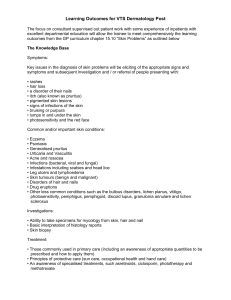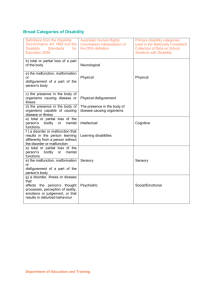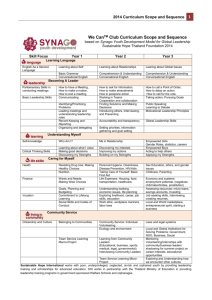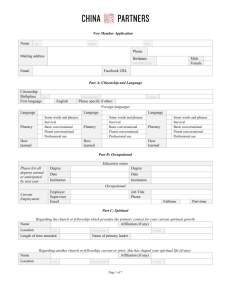Experiment 1 - ePrints Soton
advertisement
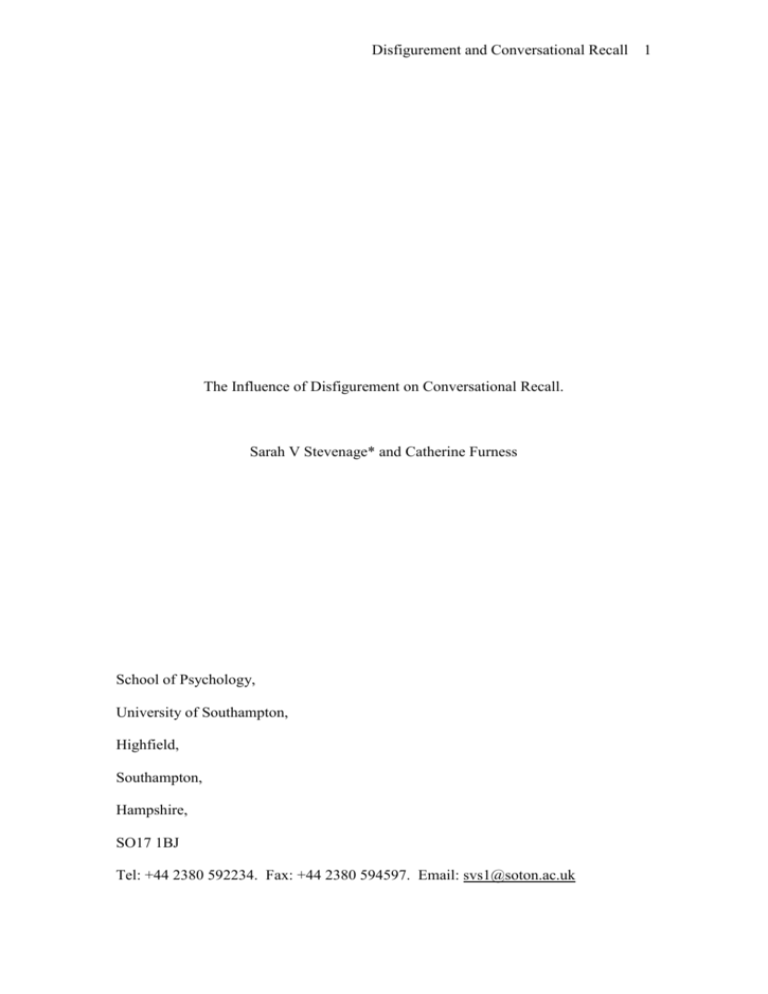
Disfigurement and Conversational Recall The Influence of Disfigurement on Conversational Recall. Sarah V Stevenage* and Catherine Furness School of Psychology, University of Southampton, Highfield, Southampton, Hampshire, SO17 1BJ Tel: +44 2380 592234. Fax: +44 2380 594597. Email: svs1@soton.ac.uk 1 Disfigurement and Conversational Recall Abstract: Two experiments are reported which examine the degree to which conversational recall is affected by facial disfigurement. In experiment 1, participants viewed a video interview and then immediately recalled the information given by the speaker. Recall fell from 68% to 52% when a fake disfigurement was visible on the speaker’s face. In experiment 2, these results were replicated in a more realistic simulated webcam interaction. Again, immediate conversational recall fell substantially from 85% to 51% when the speaker had a fake disfigurement. In both experiments, however, overt reactions through personality ratings were unaffected by appearance. Reasons for such reactions are discussed, together with the value to the individual in knowing and expecting such reactions. 2 Disfigurement and Conversational Recall 3 The Influence of Disfigurement on Conversational Recall. The possession of a facial disfigurement can profoundly affect one’s quality of life, and much research has documented this from the perspective of the individual with the disfigurement. Less research has looked at the perspective of the perceiver. However, within a dyadic interaction such as a conversation, the perceiver and the individual with the disfigurement both contribute to the quality of the encounter. One perception that individuals with disfigurement commonly report is that perceivers ‘switch off from them as individuals’ (see Partridge, 1990). This has been observed through a range of social encounters (Lanigan & Cotterill, 1989) including inappropriate staring, avoidance, social distancing, and reduced help (see Lansdown, Rumsey, Bradbury, Carr & Partridge, 1997). The aim of the current study is to examine another potential consequence of ‘switching off’ – poor listening. Specifically, it is our intuition that when in a social encounter, less of a conversation is remembered when the speaker is disfigured than when not. This work is set within the context of a developing literature suggesting that not all behaviours will reveal negative attitudes to disfigurement. For instance, Latner, Stunkard & Wilson (2005) reported minimal bias against disfigurement when rankings of likeability were examined: A disfigured peer was ranked second most likeable after a non-disfigured peer, but much more likeable than a peer on crutches, in a wheelchair, with obesity, or having lost a hand. Grandfield, Thompson & Turpin (2005) discussed this inconsistency in terms of implicit and explicit indicators of attitudes. They considered that explicit indicators such as rankings of likeability may oftentimes not show any bias against disfigurement, not because no bias exists, but because such measures are more likely to be affected by social desirability effects Disfigurement and Conversational Recall 4 (Richeson & Ambady, 2003) or conscious control (Greenwald & Banaji, 1995). In contrast, implicit indicators of behaviour may be uncontaminated by conscious control. The current paper considers this point through measurement of both explicit attitudes (through personality ratings), and implicit attitudes (through the conversational recall task). It is anticipated that participants listening to a disfigured speaker will recall less of the conversation in comparison to a non-disfigured speaker, but will not evaluate them any differently in terms of personality characteristics. Experiment 1 Design A between-subjects factorial design was used, with facial appearance (disfigured, non-disfigured), actor sex, and participant sex as independent variables, and with conversational recall and personality ratings as the dependent variables. All participants viewed a staged video interview, before completing a surprise questionnaire to assess recall of spoken information and a questionnaire to assess personality ratings. Participants Eighty undergraduates (30 males) participated in return for course credit. Ages ranged between 18 and 46 years (M = 20.6 years, SD = 3.41) and all participants indicated through self-report their unfamiliarity with the actors. Participants were randomly assigned to view disfigured and non-disfigured speakers, ensuring a balance of age and gender within each group. Materials Four versions of a staged interview were generated, showing either a male or female actor, with or without a fake facial disfigurement. The disfigurement – a port- Disfigurement and Conversational Recall 5 wine stain around the left eye and temple - was created using theatre make-up applied by a professional make-up artist. Across all four video sequences, the actors played the part of an interviewee. An off-camera interviewer posed questions to which the on-screen actor gave scripted responses. The use of a standard script enabled information, mannerisms, and timing of delivery to be rehearsed and standardised as far as possible across conditions. The video sequences lasted between 311 and 317 seconds (M = 313 seconds). Memory for spoken information was assessed by means of a 20-item questionnaire with open-ended, non-leading questions covering material from the entire interview. Participants gave written answers. In addition, a rating scale was used to assess participants’ judgements of actor personality. Based on the work of Dion, Berscheid and Walster (1972), this used a 5point Likert scale to assess 11 personality traits (friendliness, attractiveness, outgoing-ness, competitiveness, intelligence, confidence, sociability, trustworthiness, self-assertiveness, emotionality, sensitivity). Five items were reverse-scored. Coding of these items was reversed prior to analysis to ensure that a high score on all items indicated a positive personality judgement. Procedure Participants were tested in small groups. The study was presented as an exploration of regional accents and prejudice so as to minimise intentional moderation of behaviour in response to the disfigurement. In reality, the actors had typical British accents. The task was identical across conditions. Participants watched the short video and then immediately completed the surprise memory questionnaire. Participants took as long as required, and were encouraged to leave answers blank rather than Disfigurement and Conversational Recall 6 guess. Answers were coded as correct if they captured the semantic essence of the conversation. In this sense, a word-for-word recollection of the spoken information was not essential but an accurate recollection of meaning was. Finally, participants completed the personality rating task where participants scored the speaker on each of 11 personality variables. The entire procedure lasted no more that 15 minutes and participants were carefully debriefed regarding the fake nature of the disfigurement in this case, and the purpose of the task. Results Conversational Recall Accuracy on the memory questionnaire was coded by the Experimenter who was blind to the condition that participants were in. Additionally, half the questionnaires were coded by a second researcher, who was blind to both the experimental condition and the purpose of the study. Inter-rater agreement was at 100% for this subset of responses. A three-way Analysis of Variance (ANOVA) on conversational recall, using actor appearance, actor sex, and participant sex as independent variables, revealed a highly significant effect of facial appearance (F(1, 72) = 15.91, p < .001). Inspection of the means confirmed that conversational recall was significantly impaired when the actor had a (fake) disfigurement (mean = 52.3%) than when not (mean = 67.5%). No effect of actor sex (F(1, 72) = 1.44, ns), or participant sex (F(1, 72) < 1, ns) emerged, and no 2-way or 3-way interactions modified these results (all Fs(1, 72) < 1.44, ns). Personality Judgement Factor analysis of the personality judgements, removing items iteratively with loadings below .7, indicated that the ratings could be represented by 2 factors labelled as sociability (Cronbach’s alpha = .808) and emotionality (Cronbach’s alpha = .703). Disfigurement and Conversational Recall 7 Together these accounted for 69% of the variance in scores. Scores on the relevant items were averaged to yield two personality indices. Separate three-way ANOVAs for each of these indices revealed no influence of actor appearance, actor sex, or participant sex, either alone or in combination with one another (all Fs(1, 72) < 3.03, ns). Thus, explicit judgements of sociability and emotionality of the speaker were unaffected by the experimental context. Discussion The results of Experiment 1 confirmed the hypothesis that conversational recall was significantly reduced when the speaker had a visible facial disfigurement. Thus, the reports made by individuals with disfigurements in terms of others ‘shutting off to them’ appear to be substantiated within a conversational setting. Personality judgements were, however, unaffected by the presence of a facial disfigurement. Thus, the negative consequences of facial disfigurement were not all-encompassing. Two possibilities exist to account for the lack of effect of disfigurement on personality judgements. First, it is possible that these judgements could be made on the basis of reflection and, as such, were less affected by first impressions. This explanation allows for the possibility that the social skills of the speaker can moderate initial judgements (see Robinson, Rumsey & Partridge, 1996). A second and simpler explanation is that personality judgements may have been affected by social desirability effects: participants may not have wanted to give overt negative judgements to an individual with a disfigurement, even though they may have held them. Nevertheless, the outcome was that judgements of personality were unaffected by facial disfigurement. The results of Experiment 1 are important in revealing an influence of disfigurement on conversational recall. Given the sensitivity of such a finding, it is Disfigurement and Conversational Recall 8 important to replicate this result in as realistic a scenario as possible. This is the purpose of Experiment 2. Experiment 2 Whilst the use of a video sequence in Experiment 1 minimised the problems associated with reactions to ‘paper people’ (see Murphy, Herr, Lockhart & Maguire, 1996), the methodology may be criticised for lacking realism. Specifically, the absence of any interaction may have reduced participant motivation to control any negative reactions. To address this weakness, Experiment 2 used a simulated webcam interaction. The benefit of this methodology was that the duration and style of interaction could still be controlled whilst the realism of the interaction was improved. Based on Experiment 1, it was anticipated that participants would again show poorer conversational recall when ‘interacting’ with a disfigured actor than a non-disfigured actor, but that personality ratings would be unaffected. Method Design A between-subjects design was used varying the appearance of the actor (disfigured, non-disfigured). In both conditions, participants engaged in a simulated webcam interaction followed by the conversational recall task, and the personality rating task. Participants Twenty-two undergraduates (10 males) participated in return for course credit. Ages ranged between 17 and 60 years (M = 28 years, SD = 14.11) and all participants were unfamiliar with the actor in the videos. Again, participants were randomly assigned to experimental condition. Disfigurement and Conversational Recall 9 Materials Given the lack of any effect of actor sex in Experiment 1, the current experiment used only a male actor. Two versions of a video sequence were created depicting the actor with, or without, a fake disfigurement. As in Experiment 1, the disfigurement (a port-wine stain) was applied by an experienced makeup artist. The video showed the actor speaking directly to the camera, giving answers to questions that the participants believed they had asked via a webcam link. Hence, the actor’s responses were separated by pauses that allowed the delivery of the next scripted question by the participant. The entire video sequence lasted for 6 minutes. As in Experiment 1, a 20-item questionnaire was constructed to assess conversational recall. Open-ended, non-leading questions addressed all aspects of the conversation. Additionally, a modified 5-point Likert-type scale was used to assess 11 personality traits (sociability, friendliness, excitability, strength of character, toughness, competitiveness, likable-ness, confidence, attractiveness, intelligence, trustworthiness). Seven items were reverse-coded. Procedure Participants were tested individually within a research cubicle. The webcam was activated, such that the power light blinked on. Participants thus had the expectation that they were taking part in a live interaction via the webcam. They saw the face of the actor on-screen and were asked to engage in an on-line conversation with him. Participants were given a series of questions that they were told the ‘actor’ was expecting to answer. When the experimenter pressed the keyboard, the actor’s video sequence began and the participant was instructed that the webcam was active and they could begin with their first question. The actor responded to each question with a scripted answer, and then waited on-screen apparently for the next question. Disfigurement and Conversational Recall 10 For all but one participant, verbal feedback gave no indication that the participant realised the simulated nature of the experiment. This one participant was excluded and replaced within the experimental design. Following the interaction, participants were given the surprise memory questionnaire. Participants gave written responses at their own pace, and were asked to leave answers blank rather than guess. Answers were coded as correct if they captured the semantic essence of what was said in the video. Finally, participants completed the personality rating task. The entire procedure lasted no more than 25 minutes. Again, participants were carefully debriefed, particularly with reference to the simulated nature of the interaction and disfigurement, and the purpose of the task. Results Conversational Recall Performance on the memory questionnaire was coded as in Experiment 1 and inter-rater agreement was again at 100%. Accuracy of conversational recall was compared across the disfigured and non-disfigured speakers by means of an independent samples t-test. As in Experiment 1, conversational recall was significantly worse when the speaker had a disfigurement (mean = 50.5%, se = 3.90) than when of normal appearance (mean = 84.5%, se = 5.78), t(20) = 4.89, p < .001. Thus, the finding of Experiment 1 was replicated here with a more realistic task. Personality Judgements The ratings for each of the personality items were scored and subjected to Factor Analysis as in Experiment 1. This indicated that the personality ratings could be represented by 2 factors labelled sociability (Cronbach’s alpha = .67) and strength Disfigurement and Conversational Recall 11 of character (Cronbach’s alpha = .583). Together these accounted for 62% of the variance in scores. As in Experiment 1, scores on the relevant items were averaged to yield two personality indices. Analysis by means of two independent samples t-tests confirmed that facial appearance had no effect on either of the personality indices (both ts(20) < 1, ns). Again, these results support the findings of Experiment 1 and confirmed that explicit judgements of speaker personality were unaffected by the experimental context. Discussion The purpose of the present paper was to examine the possibility that negative reactions to facial disfigurement could be demonstrated within a dyadic interaction, through a reduction in the amount of information that could be remembered from a conversation. In both experiments, this prediction was confirmed: significantly less information was recalled when the speaker was disfigured than when not. This result is novel and striking in terms of its magnitude and health implications. Put bluntly, these results confirm the quality of life judgements that individuals with facial disfigurements make when they say that others avoid personal and interpersonal contact. Two possibilities emerge by way of explanation for the conversational recall effect. First, it is possible that poor conversational recall is the result of cognitive distraction so that instead of listening to the conversation, participants are distracted by intrusive thoughts or ruminations about the disfigurement itself or its implications for the speaker. Hence, poor conversational recall might be the result of poor conversational encoding. If this is so, intrusive thoughts may distract from a speechbased task such as conversational recall, but may not distract from a more visuospatial task such as expression judgement. Second, it is possible that poor Disfigurement and Conversational Recall 12 conversational recall is the result of a threat response to facial disfigurement. A large literature exists to show threat-responses to angry faces, and the possibility exists that disfigurement also elicits this threat-reaction (see Blascovich, Berry-Mendes, Hunter, Lickel & Kowai-Bell, 2001). If this is so, then performance might be expected to be impaired on visual as well as speech-based tasks due to a generalised aversion from the disfigured face. Performance on a simple visuo-spatial task such as expression classification might therefore be instructive in teasing apart these possibilities. What should not be overlooked, however, is that negative reactions to facial disfigurement were not insidious. Whilst disfigurement significantly reduced conversational recall, it did not affect judgements of personality. The mechanism for this lack of effect is unclear. However, what is perhaps more important is the fact that negativity was not all-encompassing. In summary, the present paper demonstrated that individuals with facial disfigurement are not wrong when they report people ‘shutting off from them’. The result here was a compromised quality of interaction and it is clear to see how this may affect quality of life through reduced social opportunity, isolation and even social withdrawal. Awareness of this basic perceiver reaction may, however, be of tremendous value in two respects. First, it may enable individuals to expect stilted conversations, and to develop strategies to address the consequences. Second, it may encourage individuals not to feel personalised by perceiver reactions but instead to set them in the context of understandable and commonly experienced responses from a perceiver who is distracted. Quality of life issues clearly have as much to do with the perceiver as the perceived when set in the context of a social situation such as a conversation. Awareness of likely reactions can, however, fuel adaptive responses for Disfigurement and Conversational Recall 13 individuals with disfigurements, providing psychological and social tools with which to face the world. Disfigurement and Conversational Recall 14 References Blascovich, J., Berry-Mendes, W., Hunter, S.B., Lickel, B., & Kowai-Bell, N. (2001). Perceiver threat in social interactions with stigmatized others. Journal of Personality and Social Psychology, 80, 253-267. Dion, K., Berscheid, E., & Walster, E. (1972). What is beautiful is good. Journal of Personality and Social Psychology, 24, 285-290. Grandfield, T.A., Thompson, A.R., & Turpin, G. (2005). An attitudinal study of responses to a range of dermatological conditions using the Implicit Association Test. Journal of Health Psychology, 10(6), 821-829. Greenwald, A.G., & Banaji, M.R. (1995). Implicit social cognition: Attitudes, selfesteem and stereotypes. Psychological Review, 1, 4-27. Lanigan, S., & Cotterill, J. (1989). Psychological disabilities amongst patients with port-wine stains. British Journal of Dermatology, 121, 209-215. Lansdown, R., Rumsey, N., Bradbury, E., Carr, T., & Partridge, J. (1997). Visibly Different: Coping with Disfigurement. Oxford: Reed Educational and Professional Publishing Ltd. Latner, J.D., Stunkard, A.J., & Wilson, G.T. (2005). Stigmatized students: Age, Sex and Ethnicity effects in the Stigmatization of Obesity. Obesity Research, 13(7), 1226-1231. Murphy, K.R., Herr, B.M., Lockhart, M.C., & Maguire, E. (1996). Evaluating the performance of paper people. Journal of Applied Psychology, 71, 654-661. Partridge, J. (1990). Changing Faces. London: Penguin. Richeson, J.A., & Ambady, N. (2003). Effects of situational power on automatic racial prejudice. Journal of Experimental Social Psychology, 39, 177-183. Disfigurement and Conversational Recall 15 Robinson, E., Rumsey, N., & Partridge, J. (1996). An evaluation of the impact of social interaction skills training for facially disfigured people. British Journal of Plastic Surgery, 49, 281-289.
